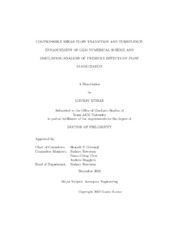| dc.description.abstract | Despite significant advancements in the understanding of fluid flows, combustion and material technologies, hypersonic flight still presents numerous technological challenges. In hypersonic vehicles turbulence is critical in controlling heat generation in the boundary layer, mixing inside the combustor, generation of acoustic noise, and mass flow in the intake. The study of turbulence in highly compressible flows is challenging compared to incompressible due to a drastic change in the behavior of pressure and a relaxation of the incompressibility constraint. In addition fluid flow inside a flight vehicle is complicated by wall-effects, heat generation and complex boundary conditions. Homogeneous shear flow contains most of the relevant physics of boundary and mixing layers without the aforementioned complicating effects. In this work we aim to understand and characterize the role of pressure, velocity-pressure interaction, velocity-thermodynamics interaction in the late-stage transition-to-turbulence regime in a high speed shear dominated flow by studying the evolution of perturbations in in a high Mach number homogeneous shear flow. We use a modal-analysis based approach towards understanding the statistical behavior of turbulence. Individual Fourier waves constituting the initial flow field are studied in isolation and in combination to understand collective statistical behavior. We demonstrate proof of concept of novel acoustic based strategies for controlling the onset of turbulence. Towards this goal we perform direct numerical simulations (DNS) in three studies: (a) development and evaluation of gas kinetic based numerical tool for DNS of compressible turbulence, and perform detailed evaluation of the efficacy of different interpolation schemes in capturing solenoidal and dilatational quantities, (b) modal investigation in the behavior of pressure and isolation of linear, non-linear, inertial and pressure actions, and (c) modal investigation in the possible acoustic based control strategies in homogeneously sheared compressible flows. The findings help to understand the manifestation of the effects of compressibility on transition and turbulence via the velocity-pressure interactions and the action of individual waves. The present study helps towards the design of control mechanisms for compressible turbulence and the development of physically consistent pressure strain correlation models. | en |


